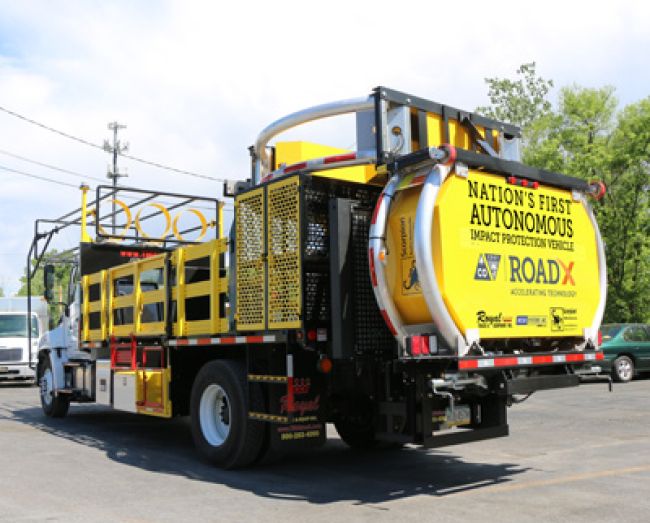
Tips for Spec’ing Impact Attenuators
Highway construction and maintenance worker fatalities have been on a steady decline for decades thanks to improved safety measures in and around worksites, including the use of following vehicles – also known as shadow vehicles – with truck- or trailer-mounted impact attenuators.
These highly visible vehicle buffers add another layer of protection for road and highway work crews by absorbing the impact of a crash from an errant vehicle. However, the industry has recognized that the current safety guidelines for these truck-mounted attenuators (TMA) and truck-trailer-mounted attenuators (TTMA) are outdated for today’s heavier vehicles and faster highway speeds, and new crash rating guidelines are due in 2020 (See “New TMA Guidelines Effective January 2020” sidebar). But in the meantime, industry executives offered several guidelines to consider when spec’ing a TMA or TTMA for today’s conditions.
The effectiveness of a TMA truck – its stopping power – depends on three core elements: the attenuator itself, the braking force of the TMA truck and the ballast used to increase the truck’s weight if necessary, said Samantha Schwartz-Lenhart, marketing and business development manager with TMA supplier Royal Truck & Equipment (https://royaltruckandequipment.com).
Attenuators – the actual buffers – are measured by their test level (TL) ratings. A TL-2 attenuator, for example, is qualified and tested to stop an impacting vehicle of a certain weight at a speed of 70 kmh (approximately 45 mph). A TL-3 attenuator is rated for 100 kmh (62 mph). “TL-3 is the maximum test level rating currently available on the market, and is the top tier for what is required when operating on highways where the average speed of traffic often exceeds those speed ratings,” Schwartz-Lenhart said.
It makes a difference whether the following vehicle will be used as a rolling or stationary buffer because that will dictate which impact and crash metrics it should meet, said Rick Mauer, marketing manager for TTMA manufacturer Gregory Industries Inc. (www.gregorycorp.com). Briefly, TMAs and TTMAs are rated based on matrices of various vehicle weights and speeds to determine the size of the following vehicle and the minimum distance it should travel when impacted. Fleet buyers then use sets of roll-ahead charts to spec the correct vehicle and attenuator.
“It is critical that the users understand the importance the roll-ahead charts play in the selection of a TMA/TTMA and how to properly use them,” Mauer said. “They need to know the mass of the vehicle they intend to mount the unit to and the roadway speed. They will also need to estimate the weight of the anticipated impacting vehicle.”
Whether the attenuator is permanently mounted on a truck or used as a trailer, today’s charts all max out with an assumed 24,000-pound impacting vehicle. However, given that highways are full of vehicles that exceed this mass, the charts represent minimum distances the TMA or TTMA vehicle can roll, Mauer noted.
Both TMAs and TTMAs are tested to the same crash test criteria and have similar performance between manufacturers’ units, Mauer said.
The truck carrying the attenuator should use air brakes, not hydraulics, for safety, Schwartz-Lenhart recommended. “When a [hydraulically braked] truck is hit by a semi, that [TMA’s] parking brake explodes on impact, so the truck has no brakes. When we do get a [truck] with hydraulics, we install the [MICO hydraulic] backup brake system.”
The TMA truck also may need to be ballasted to bring it up to acceptable weight standards. Each state has minimum weight standards for TMA trucks. They vary, but typically the standard is a minimum of 20,000 pounds.
“Ballasting a TMA can be problematic, as not all ballast is acceptable,” Mauer said. “Water and sand can’t be used. The ballast is best if it can be bolted to the frame members in such a way it will not come loose during impacts.”
About the Author: Jim Galligan has extensive experience covering the commercial truck transportation and utility fleet sectors.
*****
New TMA Guidelines Effective January 2020
Beginning January 2020, a new set of crash test guidelines for truck-mounted attenuators (TMA) and truck-trailer-mounted attenuators (TTMA) – the high-profile crash buffers protecting highway construction and maintenance workers – will take effect. At that time, utilities and contractors will have to ensure attenuators meet the new guidelines or they won’t be usable on some highway projects.
In use since the 1980s, TMAs and TTMAs following behind work crews have helped contribute to a steady decline in the number of highway construction and maintenance worker deaths. From 2008-2014, an average of 591 people died nationwide as a result of crashes in those work zones, a 21 percent drop from the 750 average annual fatalities recorded dating back to 1982, according to the Federal Highway Administration (FHWA).
Nevertheless, the current attenuator crash test standards, known as NCHRP 350, are considered outdated. The new crash test guidelines, listed in the Manual for Assessing Safety Hardware (MASH) developed by the American Association of State Highway and Transportation Officials (AASHTO), were designed to better reflect the dangers highway workers face with today’s larger vehicles and faster highway speeds. One example of the upgrades under MASH is standards for off-center impacts as well as direct hits.
Beginning in 2020, any TMA or TTMA utilized in a project that uses federal dollars for work on the national highway system must be certified by the FHWA as meeting MASH guidelines, according to AASHTO.
Although the deadline to receive certification for an attenuator that meets MASH standards is a year away, as of now only two – the Scorpion from TrafFix Devices (www.traffixdevices.com) and the Blade from Verdegro Group (www.verdegro.com) – meet the new guidelines, said Samantha Schwartz-Lenhart, marketing and business development manager for TMA supplier Royal Truck & Equipment.

